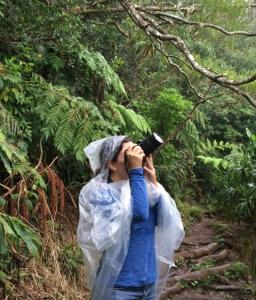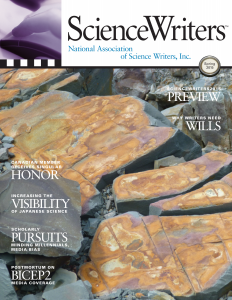How 5,000 miles changed my perspective on science writing
By Brittany Moya del Pino
Science writing is a portable career. All you need is a telephone, a computer, and reliable access to the Internet (preferably high speed) in order to do it.
For this and other reasons, I chose to leave laboratory research and enter into science writing in 2001, the year after I married. It was a decision precipitated by my husband’s choice to join the Navy. I knew we’d be moving every few years, and I didn’t want to lose grasp of my own employment options because of so much to and fro.We moved three times the first 10 years, and, honestly, it posed no hardship because two moves brought us to the vicinity of Washington, D.C., where there’s a large science writing community, as well as lots of writing jobs that generally pay well. However, when we moved to the Hawaiian island of Oahu last summer, the situation was quite different.
This is the story of how I’ve been dealing with that difference, which at times was so great that it felt as if I had moved to a foreign country. It’s about evaluating projects beyond the pay rate so that I can explore new territory and grow as a writer. I share these lessons because I hope they will be helpful no matter where you happen to live.
One of the best resources to help me survive the move and lifestyle change in Hawaii has been an online writing community organized through Google Groups.

who can look forward to having us share their stories.
We now have upwards of 20 members, including people who live in rural areas of Indiana, Vermont, California, and other states. We share messages about good days and bad days, about troublesome editors and kooky naturalists. Some members have crowd-sourced book title ideas, others have shared recaps from writing retreats or tips regarding editors who need pitches. Reading these and posting my own replies last summer made me feel that I was still connected, even though I was still drowning in cardboard boxes from the move and didn’t have time to wash my dishes, let alone pitch a story.
The time difference in Oahu was a source of apprehension. I worried that I would lose touch with people, fall out of memory, and that my flow of work would slowly dry up. So far, that hasn’t been the case, but that doesn’t mean there haven’t been challenges, including a few middle-of-the-night interviews.
Even with the capabilities of voice over IP and email, living in the middle of the world’s largest ocean made me realize how important it is to have “face time” with science: to walk into a laboratory or show up at an event and feel like I’m still close to the action.
So, I sent emails of introduction and drove to Honolulu for meetings. I requested press passes to local meetings and conferences where I hoped to find story ideas. I ordered new business cards, offering them to almost everyone I met. I also began attending the Honolulu Science Café. In September, the talk was about evolution of black holes and the birth of new galaxies. The speaker, an astrophysicist with long hair and a Hawaiian shirt, joked about having been in a rock ‘n’ roll band during his youth.
This brings me to the last important lesson from my move.

for the online tech magazine Backchannel
However, this un-crowding of my work calendar has given me time to think about new projects, ones that previously I would never have considered. Had I stayed in D.C., I would be covering the same science and medical topics that I’ve always written about. Instead, I’ve been writing about daydreams, architecture, and acoustics. I’m inspired to write stories about butterflies, spearfishing, and sustainable design, mostly because of what I’ve learned while trying to integrate with this new community and culture. I’m trying my hand, clumsily, at fiction. Even writing this first-person narrative is fresh territory for me.
I am one of a handful of science writers who live on Oahu. Together, we recently formed the Hawaii Science Writers Association. Do you know anyone here who would like to join us? We’ve found good stuff to write about at the Honolulu Science Café, which meets every month at JJ’s French Bistro, in Kaimuki. I’m sure there are other worthwhile events here that I haven’t discovered yet. It’s usually easier to find these sorts of things if you know the right people.
Brittany Moya del Pino is a freelance science writer in Kailua, Hawaii.
Resources
- The recently formed Hawaii Science Writers Association is off and running. New members are welcome. hawaiisciencewriters.wordpress.com
- Honolulu Science Café meets every month at JJ’s French Bistro, in Kaimuki.
- Technology, science, and engineering news on the islands can be found at hawaiiweblog.com.
- “Pure Hawaiian” by John Lancaster (National Geographic, Feb. 2015) provides a true picture of Hawaiian culture, not the glossy one found in travel brochures.
(NASW members can read the rest of the Spring 2015 ScienceWriters by logging into the members area.) Free sample issue. How to join NASW.




